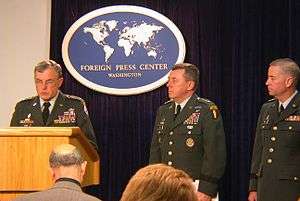Fay Report

The Fay Report was a military investigation into the torture and abuse of prisoners at the Abu Ghraib prison in Iraq. It was sparked by leaked images of Iraqi prisoners, hooded and naked, being mistreated obtained by the United States and global media in April 2004.[1] The Fay Report was one of five such investigations ordered by the military and was the third to be submitted, as it was completed and released on August 25, 2004.[1] Prior to the report's release, seven reservist military police had already been charged for their roles in the abuse at the prison, and so the report examined the role of military intelligence, specifically the 205th Military Intelligence Brigade that was responsible for the interrogation of prisoners at Abu Ghraib.[2][3] General Paul J. Kern was the appointing authority for the report and oversaw the investigation. The chief investigators were Major General George Fay, whom the report is named after, and Lieutenant General Anthony R. Jones.
The Fay Report implicated 27 members of the 205th Military Intelligence Brigade in the abuse, including four civilian contractors and an additional three military police to the seven previously charged.[2] Eight members were also cited for not reporting the mistreatment.[1] Colonel Thomas M. Pappas, who was commander and the top military intelligence officer at Abu Ghraib, along with four lower ranking officers were subject to possible criminal charges as well as administrative action and another four officers ranking higher than Colonel.[2][3] The report "revealed disturbing facts" of the cited forty-four cases of abuse, with General Kern going as far to call some of these abuses torture.[1] One example of such mistreatment cited in the report was a 'game' where guards and interrogators competed with dogs to see who could make naked teenage prisoners defecate out of fear first.[1]
In addition to the abuse, the report also cited at least eight cases of ghost detainees, or inmates hidden from the International Committee of the Red Cross and other human rights groups.[2] General Kern acknowledged there could be more than a dozen cases, and other reports later confirmed there could have been more than 100, bringing forth media questions about the role of the CIA at the prison.[4]
The report concluded that higher-ranking officials such as Lieutenant General Ricardo Sanchez, the top US commander in Iraq, and Defense Secretary Donald Rumsfeld, as well as Pentagon and Justice Department officials were not culpable but bore responsibility for creating conditions that led to the abuse and recommended further investigation.[3] These conditions included commanders being underprepared for the mass influx of prisoners, poor leadership and discipline, unclear directives, a lack of troops, and questioned how only lower ranking personnel were solely responsible for some of the 'torture methods' carried out.[2][3][5]
See also
- Carolyn Wood
- Church Report
- Ryder Report
- Taguba Report
- Formica Report
References
- 1 2 3 4 5 "Blame widens for Abu Ghraib abuse". BBC News. London. 2004-08-26. Retrieved 2015-11-11.
- 1 2 3 4 5 Komarow, Steven (2004-08-25). "30 or more implicated in Iraq abuse". USA Today. Retrieved 2015-11-11.
- 1 2 3 4 Moniz, Dave; Squitieri, Tom (2004-08-18). "Report on Iraq abuse cites interrogators, clears leaders". USA Today. Retrieved 2015-11-11.
- ↑ White, Josh (2005-03-11). "Army, CIA Agreed on 'Ghost' Prisoners". The Washington Post. Retrieved 2015-11-11.
- ↑ "Directives at Abu Ghraib were 'never clarified adequately'". USA Today. 2004-08-26. Retrieved 2015-11-11.
External links
 Media related to File:Fay Report Annex -- Statement of Specialist, 302nd Military Intelligence Battalion re -- Detainee Handling at Abu Ghraib Prison -b.pdf at Wikimedia Commons
Media related to File:Fay Report Annex -- Statement of Specialist, 302nd Military Intelligence Battalion re -- Detainee Handling at Abu Ghraib Prison -b.pdf at Wikimedia Commons Media related to Fay Report Annex -- Statement of Specialist, 302nd Military Intelligence Battalion re -- Detainee Handling at Abu Ghraib Prison -b.pdf at Wikimedia Commons
Media related to Fay Report Annex -- Statement of Specialist, 302nd Military Intelligence Battalion re -- Detainee Handling at Abu Ghraib Prison -b.pdf at Wikimedia Commons Media related to Fay Report Annex -- Statement of Sergeant, 302nd Military Intelligence Battalion re- Possible Detainee Abuse at Abu Ghraib Prison -a.pdf at Wikimedia Commons
Media related to Fay Report Annex -- Statement of Sergeant, 302nd Military Intelligence Battalion re- Possible Detainee Abuse at Abu Ghraib Prison -a.pdf at Wikimedia Commons Media related to Fay Report Annex -- Statement of Intelligence Analyst, 302nd Military Intelligence Battalion re- Detainee Treatment and Handling at Abu Ghraib Prison -a.pdf at Wikimedia Commons
Media related to Fay Report Annex -- Statement of Intelligence Analyst, 302nd Military Intelligence Battalion re- Detainee Treatment and Handling at Abu Ghraib Prison -a.pdf at Wikimedia Commons Media related to DOD Memo -- Statement of Military Intelligence Officer, A Company, 302nd Military Intelligence Battalion re -- Detainee Interrogations at Abu Ghraib Prison.pdf at Wikimedia Commons
Media related to DOD Memo -- Statement of Military Intelligence Officer, A Company, 302nd Military Intelligence Battalion re -- Detainee Interrogations at Abu Ghraib Prison.pdf at Wikimedia Commons Media related to File:Fay Report Annex- Statement of Civilian Contractor (CACI), Screener, 504th Military Intelligence Brigade re- Detainee Abuse at Abu Ghraib .pdf at Wikimedia Commons
Media related to File:Fay Report Annex- Statement of Civilian Contractor (CACI), Screener, 504th Military Intelligence Brigade re- Detainee Abuse at Abu Ghraib .pdf at Wikimedia Commons